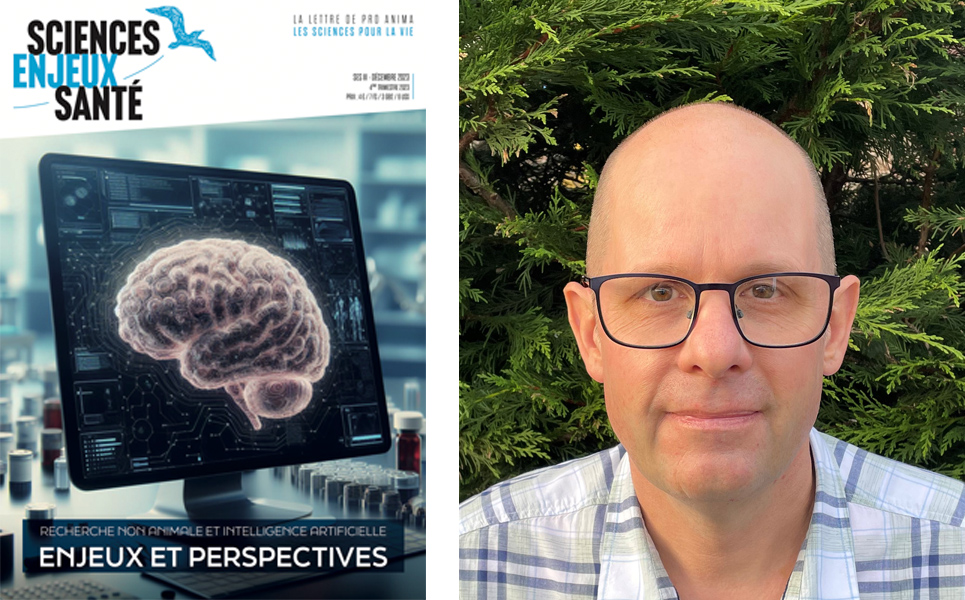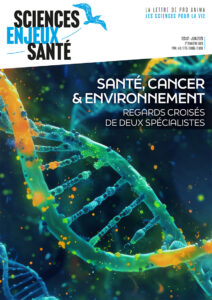
Dr Clive Roper
Director of Roper Toxicology Consulting Limited & Vice-President of ESTIV
SES111 — Dec. 2023Since his PhD in 1994 from Newcastle University and for more than 25 years, Dr Clive Roper has been an active toxicologist, having conducted projects in safety pharmacology, drug metabolism, skin absorption and dermal, genetic, and respiratory toxicology. He has developed models resulting in direct replacement of animals in skin absorption, dermal toxicology and in inhalation toxicology. Advising agencies as well as industry companies, he founded his consulting business, Roper Toxicology Consulting Limited in 2021. The company is dedicated to the use, application, and acceptance of New Approach Methodologies (NAMs). In April 2023, he was appointed Vice President of ESTIV (European Society of Toxicology In Vitro).
Dr Roper is a Fellow of the Royal Society of Biology, European Registered Toxicologist, member of the Roundtable of Toxicology Consultants, Society of Toxicology and American College of Toxicology. Dr Roper is on the board of directors of institutions and companies on both sides of the Atlantic, such as the UK NC3Rs, the US 3Rs Collaborative, and PeptiMatrix (manufacturing animal free media components).
Clive Roper shares with us his significant expertise on the development of animal-free testing in terms of scientific and regulatory needs but also for strategic business objectives.

Comité scientifique Pro Anima : For our readers, can you introduce yourself ?
Dr Clive Roper : I am a consultant in vitro toxicologist. I spent my entire career within the in vitro space. In 1990 – 1994, I was privileged to do my PhD at Newcastle University with funding from Unilever, where I developed skin absorption and metabolism tests in vitro. At my first conference, in 1991, we were told that we would not get regulatory acceptable in vitro tests in our lifetime. I was 22 years of age, and this fired me up ! The OECD Test Guideline No. 428 and accompanying OECD Guidance Document No. 28 (citing my papers) were adopted 13 years later. My ideas were incorporated into the SCCS guidance document in 2010 and I was involved in the EPA program to evaluate the dermal absorption triple pack resulting in the acceptance of OECD TG 428 in 2021. This took 30 years, but the pathway is now clear for other technologies. In 1996, I joined Charles River to run the in vitro skin absorption service. In 2010, I was promoted to Director, In Vitro Sciences, leading the in vitro metabolism, in vitro safety pharmacology, genetic toxicology, in vitrotoxicology, and in vitro respiratory toxicology teams adding to skin absorption leadership. I became involved in corporate activities such as the global 3Rs working group and evaluating organ chip companies. In 2021, I left Charles River to set up my consulting business, Roper Toxicology Consulting Limited, working with a diverse set of companies on wildly different projects including acting as an Expert Witness. I joined PeptiMatrix (https://www.peptimatrix.com) as the board chairperson after being the industry mentor in the UK ICURe program. I am a board member of the US 3Rs Collaborative, UK NC3Rs and ESTIV. I am a proud and active member of the Society of Toxicology, American College of Toxicology and Roundtable of Toxicology Consultants. I am a European Registered Toxicologist, chartered biologist, chartered scientist, and a Fellow of the Royal Society of Biology. I give the same enthusiasm and commitment to these organizations as I do to my customers.
Pro Anima : This year, you have been appointed Vice-president of ESTIV (European Society of ToxicologyIn Vitro ). Can you tell us more about ESTIV, its activities and the objectives that you would like to achieve during your mandate ?
Dr C. Roper : ESTIV (https://www.estiv.org) is a European focused toxicology society which is closely aligned with our North American partner, ASCCT (https://www.ascctox.org) and affiliated with Toxicology in Vitro, our flagship journal. Our objectives are to increase use of computational toxicology, human in vitro test systems and test methods within regulatory science and academia. Our members come from across the globe, including continental Europe, Japan, USA, India, and Canada and work in academia, industry, CROs, consulting and NGOs covering the pharma, crop protection, chemical, household and consumer products and cosmetics sectors. We are passionate about our science and educating our members and the wider community about the benefits of non-animal models.
My first objective is to increase industry membership of ESTIV. Over the past 30 years, the pharma industry has increased their discovery and safety assessment spending with no change in clinical failure rate. Pharma uses more human in vitro technologies to identify efficacious and safe drugs at a lower cost and in a shorter cycle. The move towards large molecules and new modalities have driven this faster. These new treatments are very human specific. Many are proteins which get broken down in the animal’s liver and blood resulting in no observable toxicity. Animals do not have the human specific receptors or follow the same mechanism of action, so no efficacy is seen. Human in vitro tests are overcoming these problems. Crop protection companies have committed to reduce the use of animals whilst protecting human and animal health with in vitro and computational toxicology models proving invaluable. These, often multinational, corporations are looking for innovators to answer their questions. The relationship is important as the academic technologies are spun out into small, rapidly growing, innovative vendors looking for customers.
My second objective is to bring more regulatory agencies to ESTIV. Often, there is unfair criticism of regulatory agencies in their lack of acceptance of NAMs and in vitro models. They must understand a diverse set of testing methods across safety assessment. They see many tests using different designs of organ chips with iPSCs, cell lines or primary cells. How can they understand these when they are so different and are often used to predict the same endpoint ? A great example is drug induced liver injury (DILI). A clear and concise context of use with a suitable qualification is needed to generate data to demonstrate the suitability of a test. This data gives us confidence and should be submitted to agencies so they can gain confidence too. Many companies do a lot of screening human in vitro model work and then perform the standard battery of animal tests which are submitted without the data which was used in the decision-making process. ESTIV is a fabulous place to showcase technologies in an open educational environment.

Pro Anima : In 2021, you created your own company, Roper Toxicology Consulting Limited. What are your objectives and the main missions of your company ?
Dr C. Roper : The goal of Roper Toxicology Consulting Limited is for companies to use new approach methods (NAMs) as the default procedures in regulatory safety assessment and non-animal technologies (NATs) in discovery by 2027. I believe that the quality, robustness and predictivity of the NAMs we create, with our partners, translates to safer, more efficacious drugs and chemicals, with superior value for money and in a shorter time resulting in improved patient, operator, and consumer safety due to thegreater human relevance than animal tests.
Pro Anima : Being active on both sides of the Atlantic, could you share with us the developments that you are seeing and that are occurring within regulatory agencies in Europe and in the US ?
Dr C. Roper : I can see that all agencies want to be open about what and why they will or will not accept non-animal data. They are keen to share ideas and to learn. Historically, Europe has been ahead of the US in terms of technical knowledge and regulatory acceptance. Over the past 5 – 7 years, this has changed and although the technical knowledge remains in Europe, the US EPA and FDA, with great support from NTP (NIEHS), has caught up. The EPA actively encourages stakeholders to showcase NAMs for wider adoption. The FDA has the FDA Modernization Act. In Europe, the EMA openly encourages dialogue and ECHA has been holding meetings to develop their roadmap to an animal free testing paradigm.
This took 30 years, but the pathway is now clear for other technologies
Pro Anima : During our first discussion, you mentioned the problem encountered by regulatory agencies as companies do not submit the data obtained from non-animal testing. How do you explain this kind of schizophrenic position/situation of companies believing that trying NAMs could halt or slow the progression of their products to market, while developing and using non-animal tests for their products ? How this can be overcome, according to you ?
Dr C. Roper : I have been in many meetings where regulators have asked for registrants to submit their data whilst hearing companies complain that regulators do not accept the tests. We are missing dialogue between agencies and registrants. Regulators need to understand many areas of science and want to gain confidence in NAMs or suggest areas where additional data may be needed to support the NAM in a submission. The simplest way to deal with this is to give them the validation data reports alongside the submission, or even before embarking on a testing program. There are many opportunities to discuss this with agencies including the FDA ISTAND program and EPA safe harbor.
This is compounded by registrants choosing not to submit their human in vitro data despite having made decisions using (screening) human in vitro data. The US FDA Modernization Act has freed the FDA to accept complex in vitro models and computational toxicology alongside animals. To do this, the FDA want a clear context of use and data to gain confidence in a technology. A great ongoing case study is DILI where animals cannot identify drugs causing DILI. However, we have many organ chip models used to reduce clinical DILI failure.
Pro Anima : What is your vision for the future of non-animal research ?
Dr C. Roper : In a third of a century working in the field of in vitro toxicology, progress has been slow. However, regulatory constraints are easing, the driver is no longer political (as it was for the cosmetics industry), but scientifically driven by a need to speed up bringing new products to market and to treat patients with safe and efficacious drugs. Computational models are no longer simple QSARs but use big data with machine learning to predict human outcomes.
We have come a long way from simple 2D cell models in test tubes to the complex in vitro models using tissues, co-culture organoids, spheroids and transwell plates in organ chip supported by physiological animal free, chemically derived media and engineering solutions accompanied by new techniques such as cell painting supplementing pathology and an ever-expanding selection of bioanalytical biomarker, chemical and metabolite bioanalytical methods.
In the future, our damaged organs will be replaced with bioprinted organs using our own cells, although not in my lifetime, and in vivo and in vitro test methods will have been replaced by computational models.
Read More
Clive graduated with a PhD in in vitrodermal absorption from Newcastle University in 1994 followed by a post-doctoral research position in human nutrition. In 1996, he joined Charles River to develop the in vitro skin penetration service. In 2010, he was promoted to Director, In Vitro Toxicology leading the skin absorption, routine regulatory in vitro toxicology, genetic toxicology, safety pharmacology, and in vitro respiratory toxicology teams.
In 2021, Clive set up his consulting business, Roper Toxicology Consulting Limited. He aids his clients in the development and regulatory adoption and acceptance of NAMs and testing using NAMs for biotech, mid-tier, and multinational clients. Clive has presented at, and organized, many conferences. Clive has authored and co-authored many posters and abstracts as well as peer review papers with his papers quoted in OECD TGs 428 & 492. He authored an OECD Case Study for an inhalation toxicity NAM in 2022. He is a peer reviewer for journals including TIV and Regulatory Pharmacology & Toxicology.
He has advised agencies (e.g., NIH, SCCS, Health Canada and EPA) as well as industry bodies and companies. He has developed models resulting in direct replacement of animals in dermal absorption and toxicology and inhalation toxicology. Clive serves on the boards of the US 3Rs Collaborative, ESTIV, UK NC3Rs and PeptiMatrix. He is a member of the Roundtable of Toxicology Consultants, Society of Toxicology and American College of Toxicology. He is a chartered biologist and scientist, a European Registered Toxicologist and a Fellow of the Royal Society of Biology.
Image credit: Clive Roper - Istock – Deposit photo


